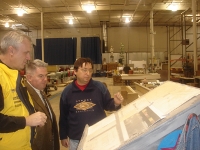Midway Memorial - Dauntless Exhibit
The Battle
At 10:25 on the 4th of June, 1942, fifty U.S. Navy Dauntless dive-bombers pealed off and attacked three of the four aircraft carriers in the amassed Japanese armada poised to take the island of Midway. At 10:26, there were three burning hulks. Dauntlesses then attacked the fourth carrier. Within those few minutes the Dauntless force destroyed 47% of the enemy carrier tonnage and changed the course of the Pacific war.
The Naming of Midway Airport
On June 23rd, 1949, the City Council of Chicago changed the name of its “Municipal Airport” To Midway Airport “in honor of the heroes of the battle of Midway, … the men who turned the tide of the battle in the Pacific.” Ald. Therone W. Merryman (45th) a member of the Aero Commission “eloquently outlined the reasons for wishing to rename the airport;” …at the battle of Midway the air forces sank the Japanese carriers and “routed the Japanese fleet.” Orchard Field had just previously been renamed for Butch O’Hare who single handedly saved the Yorktown, which subsequently carried the Dauntlesses to victory at Midway.
The Chicago Connection
In the early 1940s, from 1942 to 1945, Chicago was a central training ground for allied pilots, aircraft carrier officers, ship's deck, and flight crews. Aircraft Carrier Qualification training was conducted on Lake Michigan in order to avoid attacks from submarines which frequently patrolled the US coastline. Two former Great Lakes excursion vessels, the Sea and Bee and the Greater Buffalo, were fitted with flat tops and commissioned by the US Navy as the U.S.S. Wolverine and the U.S.S. Sable. These two vessels, which operated from Chicago's Navy Pier, provided the platforms for the pilots to prove their ability to land and take off from an aircraft carrier, after receiving training at Glenview Naval Air Station. The Lake Michigan training operation was a great success; over seventeen thousand pilots were qualified.
After the Battle of Midway, the fixed wing Dauntlesses moved to land bases. Some were transferred to Chicago, where in order to avoid U Boat assault and to provide a central training place for Allied pilots and aircraft carrier officers and crew. In Addition to the training, the Chicago war effort produced rotary plane engines at Ford City, torpedoes at International Harvester, PT boats on the north branch of the Chicago River and the atomic bomb at the University of Chicago. It took more than three more years and the atomic bomb to end the war.
The Exhibit
Good fortune now allows Chicagoans to actually see an original of these planes fully restored and properly displayed. One of the Dauntlesses which was brought to Chicago fell overboard into the lake during training. Thus it became sealed away off the shores of Chicago as a time capsule. Research divers rediscovered it just before the rebuilding of Midway Airport. It has since been fully restored and is displayed in the exhibit.
No picture or reproduction has ever had the impact of seeing the actual human carrying vehicle that turned the tide of the Second World War. Chicago has found that true artifacts such as “Sue”, the U505 and a real Picasso continue to amaze and inspire the young and inform people of all ages. This exhibit is in that great tradition.
The Committee
The Chicago Marine Heritage Society was asked by the City of Chicago to form and lead the committee to design, construct and install this exhibit. The Society accepted the invitation and introduced and accomplished the concept of an interactive educational interpretive exhibit to supplement and interpret the plane in the exhibit. The Society in partnership with A&T Recovery negotiated the arrangement with the US Navy to transfer the possession of the plane to the City so it could be displayed at the airport.
To round out the exhibit , the committee in conjunction with the Airport invited two additions to the exhibit. The first was Ellen Sandor's outstanding Battle of Midway artistic and informative interpretation of the historical events in an attractive kiosk. The second was Union League's inspirational heroic size Spirit of the Battle of Midway statue that it had commissioned years earlier.
When the initial design was completed and exhibit contractors had been identified and brought on board with the help of A. Epstein & Sons, the Society brought in the Navy League of the United States, Chicago Council, to take over the committee, collect and disperse the funding and complete the project. The Navy League continues to manage and support the exhibit including instituting a recent major renovation replacing and updating the monitors and content.









